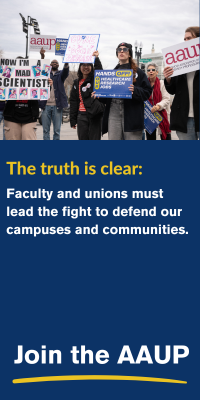- About
- Programs
- Issues
- Academic Freedom
- Political Attacks on Higher Education
- Resources on Collective Bargaining
- Shared Governance
- Campus Protests
- Faculty Compensation
- Racial Justice
- Diversity in Higher Ed
- Financial Crisis
- Privatization and OPMs
- Contingent Faculty Positions
- Tenure
- Workplace Issues
- Gender and Sexuality in Higher Ed
- Targeted Harassment
- Intellectual Property & Copyright
- Civility
- The Family and Medical Leave Act
- Pregnancy in the Academy
- Publications
- Data
- News
- Membership
- Chapters
Defending Public Higher Education in Alaska
Public colleges and universities face challenges across the country, but even in the current climate of shrinking enrollments and dwindling resources, few have faced the kind of circumstances recently confronting the University of Alaska system. Early in 2019, Alaska’s new governor, Mike Dunleavy, put forward a state budget that included a sweeping $131 million cut for UA in 2020. Had that cut been implemented, it would have been equivalent to around 19 percent of the total university budget, devastating the entire institution.
In response to the governor’s proposed cuts, the UA administration and board of regents took the immediate, and premature, step of declaring financial exigency and making plans to consolidate the system into a single institution. Fortunately, following unprecedented public opposition and the revelation that such cuts would threaten UA’s accreditation from the Northwest Commission on Colleges and Universities, the governor altered his original proposal, reducing the cuts to higher education and spacing them out over three years ($25 million in 2020, $25 million in 2021, and $20 million in 2022).
While the administration and the regents continue to struggle to find ways to absorb these losses, members of United Academics– AAUP/AFT, the UA faculty union, have worked diligently to ensure a transparent and fair process in determining how and where any cuts fall. Though administrators have shelved their plan for consolidation, they continue to look at a variety of options that will have significant implications for programs and students around the state.
In November 2019, United Academics AAUP/AFT hosted Chris Sinclair, president of the United Academics of the University of Oregon, at all three of the main UA campuses (Southeast, Anchorage, and Fairbanks) to give workshops on effective shared governance. Sinclair also made an abbreviated presentation to the UA board of regents at its regular November meeting. Abel Bult-Ito, president of United Academics AAUP/AFT, made it clear in each of these discussions that the faculty remains committed to working with the administration to best serve the students and communities of Alaska, in spite of the enormous obstacles they face.



